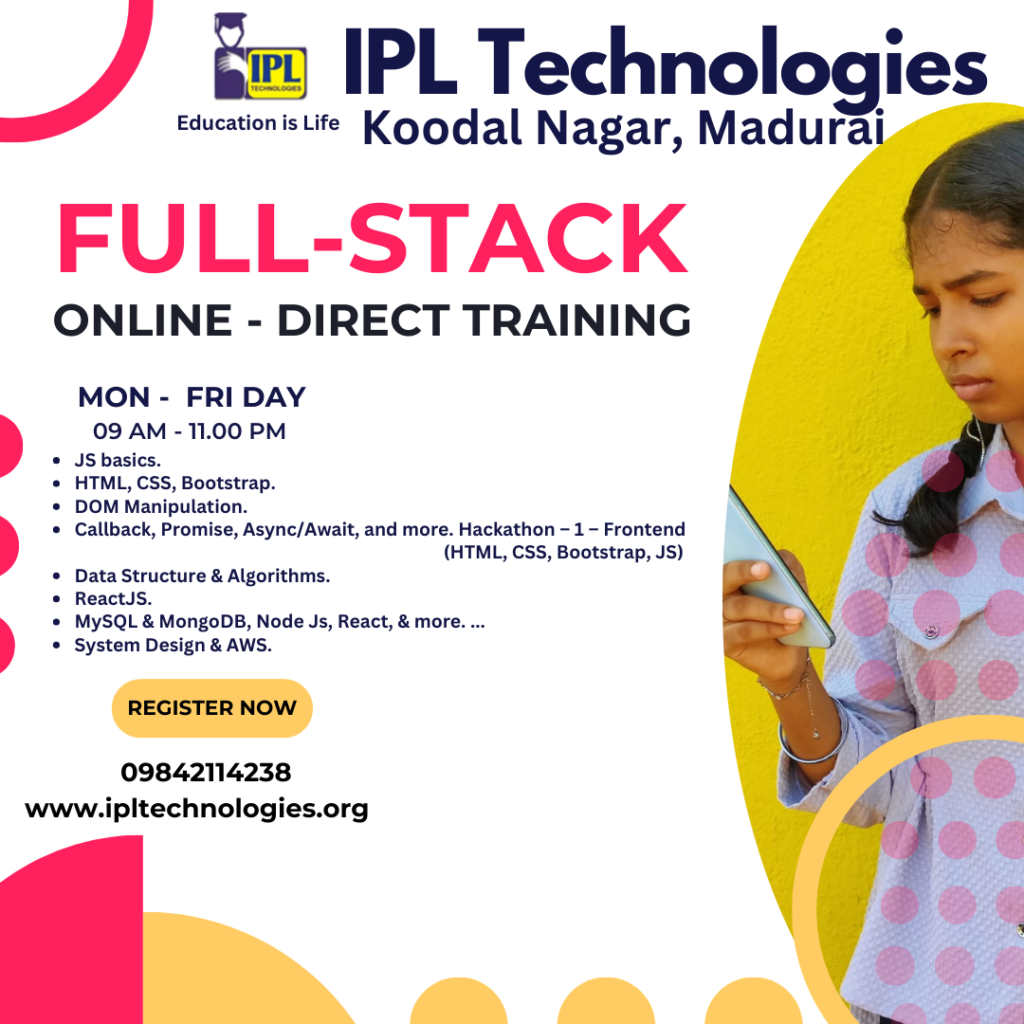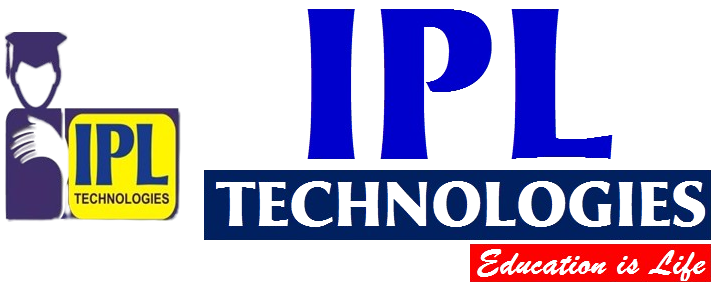Full Stack Syllabus
Course Duration: 210 Hrs
- Introduction to Full Stack Development
Explains the role of a full stack developer, covering both frontend and backend technologies used to build complete web applications. - HTML Basics
Covers the structure of web pages using HTML elements, attributes, and forms for user inputs. - HTML5 Advanced Concepts
Teaches new HTML5 elements like canvas, media tags, and semantic tags for modern web development. - CSS Basics
Explores styling of web pages with CSS properties like color, fonts, and layouts. - Advanced CSS (Flexbox and Grid)
Introduces Flexbox and CSS Grid for building responsive and complex layouts easily. - Responsive Web Design
Covers media queries to make web pages mobile-friendly and adaptable to different screen sizes. - Bootstrap Framework
Explains how to use Bootstrap to build responsive websites quickly with ready-made components. - JavaScript Basics
Teaches variables, functions, loops, and events in JavaScript for dynamic web behavior. - DOM Manipulation
Explains how to access and modify HTML elements using JavaScript’s Document Object Model (DOM). - ES6 and Modern JavaScript Features
Covers new JavaScript features like arrow functions, destructuring, and template literals. - JavaScript Events and Callbacks
Teaches event handling and callback functions to create interactive web pages. - JSON and AJAX Basics
Introduces JSON format for data exchange and AJAX for asynchronous communication with servers. - Version Control with Git
Explains how to use Git for source code management, including branching, merging, and pull requests. - GitHub and Collaboration
Covers the basics of GitHub and how to collaborate on projects using repositories and workflows. - Introduction to Package Managers (npm & yarn)
Teaches how to manage project dependencies using npm and yarn. - Introduction to Web APIs
Explains the role of RESTful and third-party APIs in web development. - Frontend Frameworks Overview
Provides an introduction to popular frontend frameworks like React, Angular, and Vue. - React Basics
Covers components, props, and state in React for building user interfaces. - React Router
Teaches how to create single-page applications (SPAs) with React Router for client-side routing. - React Hooks and Context API
Explores React hooks like useState and useEffect along with the Context API for global state management. - Redux for State Management
Introduces Redux for managing the state of large-scale applications in React. - Introduction to Angular
Covers the basics of Angular, including components, services, and directives. - js Basics
Explains the core concepts of Vue.js, including directives, templates, and component architecture. - SASS and Preprocessors
Teaches how to use SASS for writing modular and reusable CSS styles. - Introduction to TypeScript
Covers the use of TypeScript for building scalable and type-safe JavaScript applications. - js Basics
Explains the basics of Node.js, a JavaScript runtime, for backend development. - js Framework
Covers how to use Express.js to build RESTful APIs and handle routing. - Middleware in Express.js
Teaches how middleware functions are used in Express.js for request handling. - Database Basics
Introduces relational and non-relational databases like MySQL, PostgreSQL, and MongoDB. - CRUD Operations with SQL
Covers SQL queries for creating, reading, updating, and deleting records in relational databases. - MongoDB Basics
Teaches the use of MongoDB, a NoSQL database, for storing unstructured data. - Mongoose in Node.js
Explains how to use Mongoose for schema-based interaction with MongoDB. - Authentication and Authorization
Covers user authentication strategies like JWT and OAuth, and role-based authorization. - Session Management in Web Applications
Teaches how to handle user sessions using cookies and sessions in Express.js. - File Uploads and Handling
Covers how to upload files and handle them on the server side using Node.js. - Introduction to WebSockets
Explains WebSocket protocols for real-time communication between client and server. - API Development with Node.js and Express
Teaches how to create and expose RESTful APIs using Node.js and Express. - Introduction to GraphQL
Covers GraphQL, a query language for APIs, and how to build APIs with it. - Testing Basics with Jest and Mocha
Explains how to write unit tests for JavaScript code using Jest and Mocha frameworks. - Frontend Testing with React Testing Library
Covers how to test React components using React Testing Library and Jest. - Backend Testing with Postman
Teaches how to use Postman to test APIs during backend development. - Security Best Practices
Explains security measures like data encryption, validation, and protection against common vulnerabilities. - Performance Optimization
Covers techniques for optimizing frontend and backend code to improve performance. - Introduction to DevOps
Provides an overview of DevOps practices, including CI/CD pipelines. - Deployment Basics
Explains how to deploy web applications on platforms like Heroku and Vercel. - Docker and Containerization
Teaches how to use Docker for containerizing applications for consistent deployment. - Introduction to AWS Services
Explains how to use AWS for hosting web applications and handling cloud infrastructure. - Continuous Integration (CI) with Jenkins
Covers how to automate the build and testing process with Jenkins. - Microservices Architecture
Teaches how to structure applications as a collection of small services. - Introduction to Serverless Architecture
Explores serverless platforms like AWS Lambda for building scalable apps without managing servers. - Progressive Web Apps (PWAs)
Explains how to build web applications that function like native apps with offline support. - Static Site Generators
Covers frameworks like Gatsby and Next.js for building static sites. - Introduction to Headless CMS
Teaches how to use headless CMS like Contentful for managing content. - Mobile Development with React Native
Covers the basics of building mobile apps using React Native. - Introduction to Hybrid Mobile Apps
Explains how to use Ionic and Cordova for building cross-platform mobile apps. - State Management in Mobile Apps
Covers Redux and Context API for managing mobile app states. - Monitoring and Analytics
Teaches how to use tools like Google Analytics for tracking application performance. - Error Handling and Logging
Covers error logging frameworks for tracking bugs in both frontend and backend. - SEO Optimization for Web Apps
Explains SEO techniques for improving web app visibility on search engines. - Introduction to Agile Methodology
Covers Agile principles and how to apply Scrum in development projects. - Building a Portfolio Website
Teaches students how to create personal portfolio websites to showcase their projects. - Client-Side Rendering vs Server-Side Rendering
Explains the differences between CSR and SSR and their use cases. - Setting Up a Blog using CMS
Teaches how to set up and manage a blog using WordPress or other CMS. - Email Integration in Applications
Explains how to send emails from applications using services like SendGrid. - Payment Gateways Integration
Teaches how to integrate payment gateways like Stripe and PayPal. - API Rate Limiting and Throttling
Covers how to implement rate limiting to protect APIs from overuse. - Web Accessibility Best Practices
Explains techniques to ensure web applications are accessible to all users. - Image Optimization for Web
Covers techniques for optimizing images to improve web page load speed. - Caching Strategies
Teaches how to use caching (like Redis) to improve performance. - OAuth and Social Logins
Explains how to integrate Google, Facebook, and other social login methods. - Using Firebase for Realtime Databases
Teaches how to integrate Firebase for real-time data sync. - Build Tools (Webpack, Babel)
Covers the use of Webpack and Babel to bundle and transpile code. - Project Management Tools (Trello, Jira)
Explains how to use tools like Trello and Jira to manage development tasks. - Capstone Project Development
Students will apply all learned concepts in a final full-stack project. - Presentation and Portfolio Submission
Teaches students how to present their capstone project and build an impressive portfolio.

